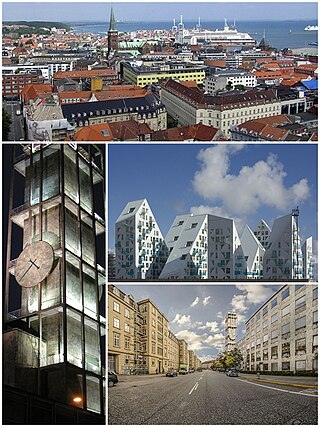
Aarhus is the second-largest city in Denmark and the seat of Aarhus Municipality. It is located on the eastern shore of Jutland in the Kattegat sea and approximately 187 kilometres (116 mi) northwest of Copenhagen.
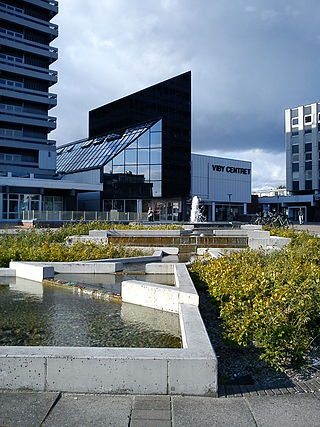
Viby J is a former town and now a district, in the southwestern part of Aarhus in Denmark. The district has almost 30,000 inhabitants. The "J" stands for Jutland, as there is another town called Viby on the island of Zealand, officially referred to as Viby Sj and also a village on Funen.
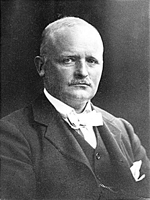
Hack Kampmann was a Danish architect, Royal Inspector of Listed State Buildings in Jutland and professor at the architecture department of the Royal Danish Academy of Fine Arts. Marselisborg Palace in Aarhus, built between 1899 and 1902, is among his best known works.

The Aarhus Theatre in Aarhus, is the largest provincial theatre in Denmark.

Aarhus River is a 40-kilometre (25 mi) long river, in eastern Jutland, Denmark.

Godsbanen is a cultural centre in central Aarhus, Denmark since 2012. The site and most of the buildings are a former goods station, known as "Aarhus Godsbanegård", which was in use from 1923 to 2000. It is located at the end of a broad sidetrack to the central railway yard of Aarhus. In December 2010, Realdania announced that the area would be gradually transformed into a modern city district, through a collaborative project with Aarhus Municipality. Apart from the new cultural centre of Godsbanen, there are plans to build several buildings and institutions along the former railway yard, including a new school of architecture.

The Port of Aarhus is a deep-sea port located in the city of Aarhus. It is the largest container port in Denmark, handling more than 50% of country's container traffic. The Port of Aarhus shipped roughly 8.4 million metric tonnes of cargo in 2017.

The 1944 explosion in Aarhus or the 4th of July Disaster was an explosion in the city of Aarhus, Denmark when a barge loaded with ammunition exploded in the harbor, killing 39 people and injuring another 250.
The following is a timeline of the history of the city of Aarhus, a city in central Denmark.

Aarhus Business College is a business school of secondary education in Aarhus, Denmark. The school offers educational programmes in business and management on a secondary level to post-primary youth, Higher Commercial Examination Programme (HHX) and supplementary courses for adults seeking to maintain qualifications. Last but not least Aarhus Business College has two new types of educations called EUX Business and EUD Business. EUX is an education that combines a 2-year secondary education with a 2-year internship in a company, and EUD is 1 year in school and a 2-year internship in a company. It is an independent self-owned institution under the Danish government, managed by a board composed of members from the business community in conjunction with a rector that oversees day-to-day operations. The school is located on three addresses in Aarhus: Campus Sønderhøj in Viby J and the two campuses of HHX in Risskov and Viby J.
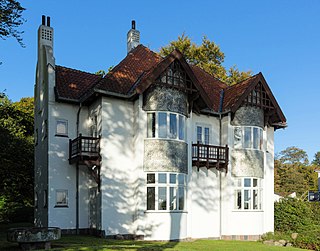
Villa Kampen is a listed building in Aarhus, Denmark, constructed by architect Hack Kampmann between 1901 and 1902, during his tenure as the Royal Building Inspector for Northern Jutland. Villa Kampen is a villa situated in Midtbyen in central Aarhus, in the affluent neighbourhood around Strandvejen south of the neighbourhood Marselisborg. It lies next to Havreballe Forest behind it and to the west, with an east-facing view of Tangkrogen and the Bay of Aarhus in front of it and the Marselisborg Forests visible on the hills to the south. The building and the surrounding estate was listed on 2 March 1983 by the precursor to the Danish Heritage Agency.
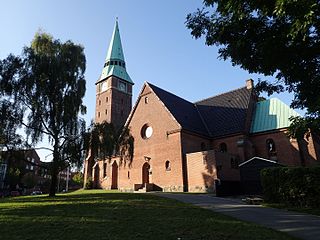
St. John's Church is a congregation of the Church of Denmark in Aarhus, Denmark. The parish church is situated in the Trøjborg neighbourhood, immediately north-west of Nordre Cemetery. In 2015, Saint Johannes Parish counted some 8,916 members.

Aarhus Old City Hall is the former city hall of Aarhus, Denmark, and a listed building. The city hall was built in 1857 and was listed in the Danish national registry of protected buildings and places by the Danish Heritage Agency on 18 March 1996. It is the second, and oldest preserved, city hall of Aarhus.

Mejlen or Asylet Børnely is a house, former asylum and a listed building in Aarhus, Denmark. The house was built in 1768 and was listed in the national Danish registry of protected buildings and places by the Danish Heritage Agency on 8 November 2008. The building originally functioned as a kindergarten but is today home to an art gallery.

Vester Allé 12 is a listed building in Aarhus, Denmark. The building was completed in 1902 and was listed by the Danish Heritage Agency in the Danish registry of protected buildings and places on 5 April 1988. The building is situated on the west side of Vester Allé close by Vester Allé Barracks and ARoS Aarhus Art Museum. The building has been home to some of the earliest cultural institutions in the city.
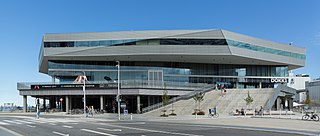
Dokk1 or Dokken is a government building, public library and culture center in Aarhus, Denmark. It is situated on Hack Kampmanns Plads in the city center by the waterfront next to the Custom House. Dokk1 is part of the much larger development project Urban Mediaspace Aarhus, jointly financed by Aarhus Municipality and Realdania for 2.1 billion DKK. It is designed by Schmidt Hammer Lassen Architects and Kristine Jensen, with construction managed by NCC AB. Construction broke ground 8 June 2011 and the building was inaugurated four years later on 20 June 2015.
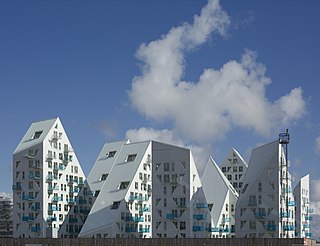
Isbjerget is a residential building in the Aarhus Docklands neighborhood in Aarhus, Denmark. It is situated on the waterfront on Mariane Thomsens Gade and was finished in 2013 after three years of development. The building was designed by four architectural firms, the Danish CEBRA and JDS Architects, French Louis Paillard and Dutch SeARCH, and was funded by the Danish pension fund PensionDanmark.
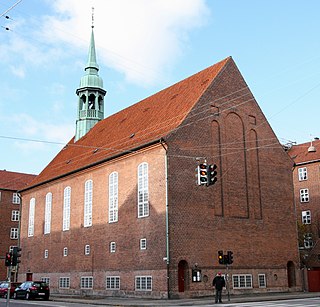
Thomas Laub Hansen Havning was a Danish architect, illustrator, writer and royal building inspector born in Nyboder, Copenhagen on 4 September 1897.

The architecture of Aarhus comprises numerous architectural styles and works from the Middle Ages to present-day. Aarhus has a well-preserved medieval city center with the oldest dwellings dating back to the mid-1500s and some ecclesiastical structures such as St. Clemen's Cathedral and numerous smaller churches that can be traced back to the 1100s. The industrialization of the 19th and 20th centuries left distinctive industrial structures, important National romantic works and some of the best examples of Functionalist architecture in the country. The history of the city as a Viking fort is evidenced in the street layout of the Latin Quarter, the wider Indre By neighborhood testifies to its later role as a Market town and center of commerce while the Frederiksbjerg, Trøjborg and Marselisborg districts showcase the first cohesive urban planning efforts of the early 20th century.

The Aarhus Courthouse is a historic building located on Vester Allé in Aarhus, Denmark. Originally built as a combined Courthouse and jail, it now serves as the seat of Aarhus County Court while the High Court of Western Denmark, based in Viborg, has a courtroom there. Inaugurated in 1906, it was built to the design of L.A. Ludvigsen and Julius Hansen in the Art Nouveau style.




















